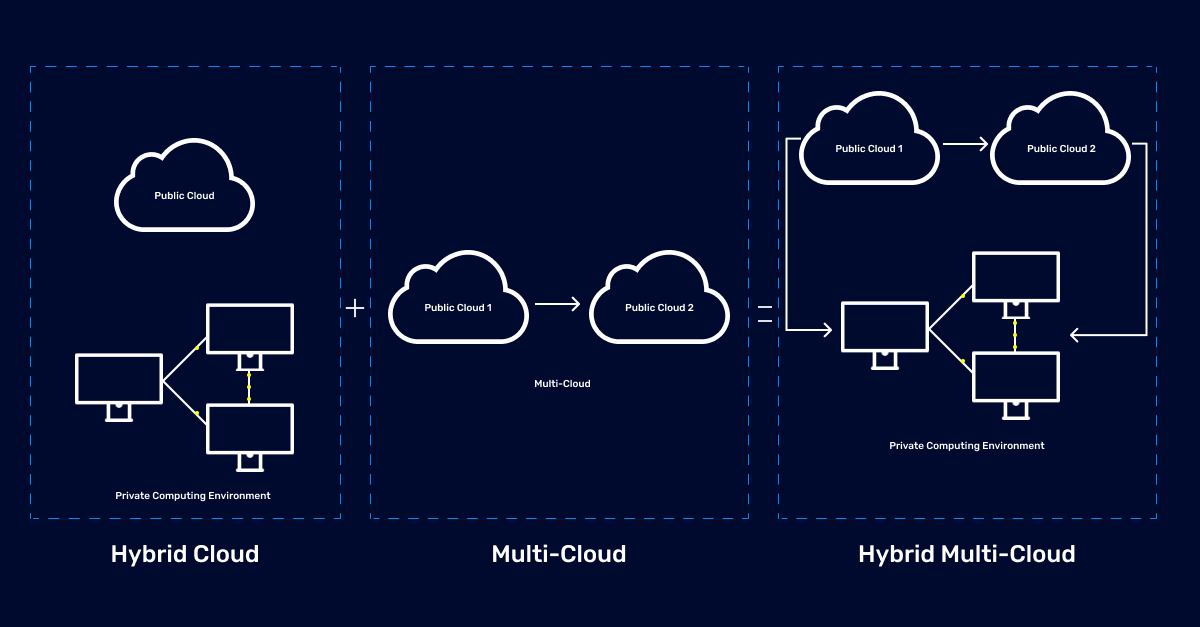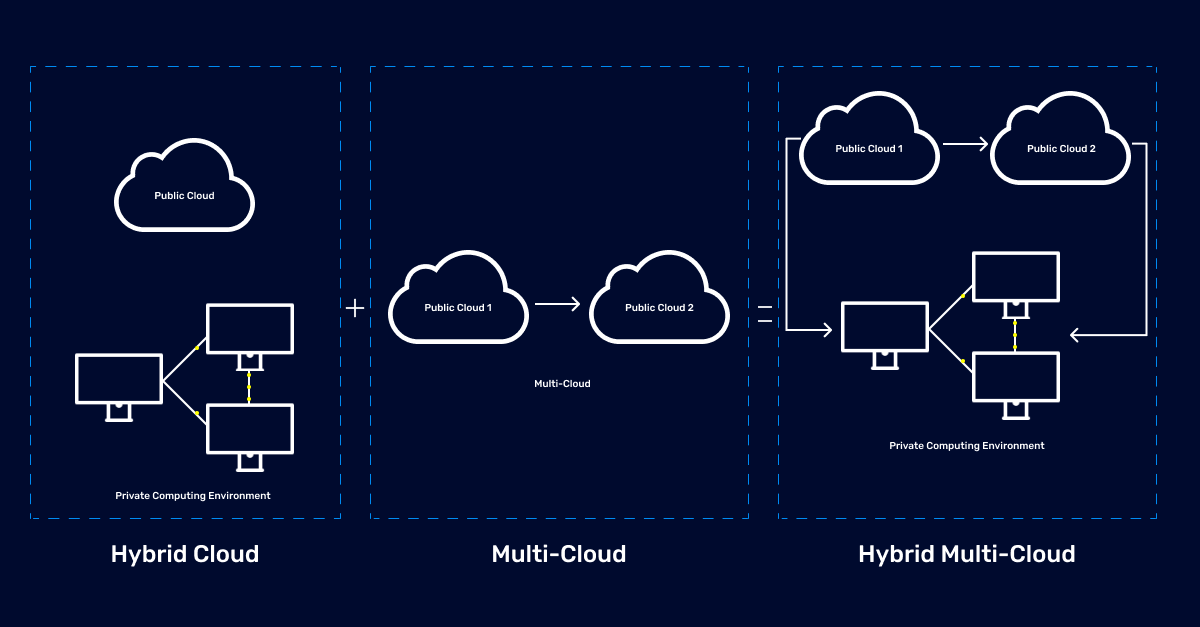Hybrid vs Multi-Cloud: Everything You Need to Know
Navigating the Clouds: A Comprehensive Guide to Hybrid and Multi-Cloud Strategies
...26/03/2024 | 5 Minute Read
Administration Solutions Specialist

A Hybrid Multi-Cloud Strategy: The Basics
The realm of hybrid multi-cloud computing is a vast and enticing landscape with promises of flexibility, scalability, and access to top-tier cloud services. However, understanding its intricacies can sometimes feel like decoding ancient hieroglyphics. This article aims to provide a solid basis of the main things you need to know about hybrid multi-cloud.
Dissecting the Jargon:
To begin our journey, let’s clarify some key terms:

- Hybrid Cloud: This refers to a blend of public cloud resources and on-premises infrastructure, offering both the agility of the cloud and the control of on-premises solutions.
- Multi-Cloud: Multi-cloud involves using services from multiple cloud providers simultaneously, enabling organisations to leverage the strengths of different platforms and avoid vendor lock-in.
- Hybrid Multi-Cloud: The pinnacle of cloud architecture, hybrid multi-cloud combines both private and public clouds from various providers, creating a versatile ecosystem.
Designing Your Hybrid Multi-Cloud Environment
Within the realm of hybrid multi-cloud, there are different architectural paradigms to explore:
- Highly Cohesive:
Imagine a closely integrated environment where resources in your private cloud and multiple public clouds act as one cohesive unit. This often involves:
- Shared services: Services like authentication, data management, and security are centralised across all cloud environments.
- Standardised tools: Consistent management tools orchestrate workloads across clouds, offering unified visibility and control.
- API-driven communication: Applications seamlessly interact with resources across different clouds using APIs.
- Decentralised:
Think of this as a less interconnected approach, where each cloud environment operates somewhat independently. Here’s what it typically involves:
- Decentralised services: Each cloud maintains its own authentication, data management, and security services.
- Limited tool integration: Management tools focus on individual cloud environments, with some level of interoperability.
- API-based communication: APIs facilitate communication between applications in different clouds, but the focus is on data exchange, not orchestration.
- Complex management: Overseeing multiple independent environments can be cumbersome.
- Integration overhead: Building and maintaining custom API integrations can be time-consuming.
- Federated:
This approach emphasises collaboration and data sharing between clouds while maintaining autonomy. Key characteristics include:
- Standardised governance: A common set of policies and regulations guides data management and security across clouds.
- Interoperable protocols: Open standards facilitate seamless data exchange and communication between clouds.
- Decentralised services and tools: Each cloud maintains its services and tools but interoperates through standardised protocols.
Key Components of a Hybrid Multi-Cloud Foundation
Conquering the complexities of a hybrid multi-cloud environment requires more than just connecting various cloud infrastructures. To thrive in this ever-evolving landscape, you need a strategic approach that ensures seamless operation across all fronts. Here’s a closer look at the key elements that form the foundation of a well-functioning multi-cloud strategy:
- Interoperability: Imagine your clouds speaking different languages. APIs, cloud management platforms, and hybrid network solutions are your Rosetta Stones, ensuring smooth communication and data exchange.
- Security: This is like building a fortress around your entire cloud kingdom. Invest in robust identity management, encryption, and threat detection tools. Remember, even the strongest walls need constant vigilance.
- Workload Placement: Not all workloads are created equal. Match them to the right cloud based on performance, compliance, and security needs. Containerisation technologies can be your portable battering ram, enabling seamless movement between environments.
- Monitoring and Management: Gaining a bird’s-eye view of your entire multi-cloud dominion is crucial. Centralised monitoring platforms are your watchtowers, while automation tools act as your loyal scouts, optimising resource management.
- Cost Optimisation: Every penny counts, so monitor spending closely. Cloud cost management tools and resource allocation strategies are your economic advisors, helping you avoid resource bloat.
Essential Tools for a Hybrid Multi-Cloud Strategy
Taming the complexities of a hybrid multi-cloud environment demands more than just cloud resources. You need a robust arsenal of tools to automate, manage, and secure your operations across diverse cloud providers. Here are the key weapons in your multi-cloud toolkit:
- 1. Infrastructure as Code (IaC): Instead of manual cloud configuration, IaC automates provisioning and management across all your clouds. Think efficiency, consistency, and reduced human error.
- 2. API Management: APIs are the bridges between your cloud resources. API management acts as your gatekeeper, enforcing governance and controlling access to ensure only authorised services can interact with your data and applications.
- 3. Cloud-Native Technologies: Containerisation technologies like Docker and Kubernetes package your applications into portable units, enabling seamless movement and scaling across different cloud environments. Microservices architectures further enhance this agility by breaking down applications into smaller, independent units. Think nimble, scalable, and cloud-agnostic applications.
- 4. GitOps: Say goodbye to complex deployments and configuration drifts. GitOps leverages Git repositories to manage infrastructure and applications declaratively. This means your desired state is defined in code, enabling version control, automated deployments, and consistent environments across clouds.
The Challenges of a Hybrid Multi-Cloud Strategy
No victory comes easy, and the hybrid multi-cloud presents its own set of challenges:
- Complexity: Managing diverse environments requires specialised skills and robust tooling. Invest in training and consider managed service providers as your mercenary allies.
- Security: Maintaining consistent security across various clouds can be intricate. Implement centralised policies, leverage security-focused tools, and prioritise continuous assessment. Remember, vigilance is key.
- Vendor Lock-in: Don’t become a prisoner to a single cloud provider. Open-source tools, standardised APIs, and cloud-agnostic solutions are your escape routes.
- Cost Management: Monitor spending like a hawk. Utilise tools for cost analysis and forecasting, and optimise resource allocation to avoid financial ruin.
The Future is a Hybrid Multi-Cloud Strategy
As the landscape evolves, emerging technologies such as serverless computing and edge computing offer new avenues for enhancing your multi-cloud arsenal, providing cost-effectiveness, agility, and real-time processing capabilities.
In conclusion, a solid understanding of the basics, coupled with strategic planning and the right tools, is essential for harnessing the full potential of a hybrid multi-cloud strategy in today’s dynamic digital landscape.
Ready to take the next step towards a smarter cloud strategy? Unlock the potential of hybrid and multi-cloud environments tailored to your business needs. Contact us to start your journey to a more flexible, secure and efficient cloud infrastructure today.